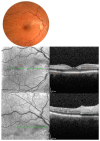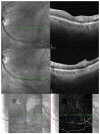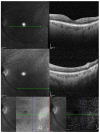Hyperbaric Oxygen Therapy in Ophthalmology: A Narrative Review
- PMID: 38202036
- PMCID: PMC10779579
- DOI: 10.3390/jcm13010029
Hyperbaric Oxygen Therapy in Ophthalmology: A Narrative Review
Abstract
Hyperbaric oxygen therapy (HBOT) has been used for the past 50 years for conditions such as decompression disease and wound healing. It has promising effects in the treatment of vision-threatening diseases, such as retinal artery occlusion, retinal vein occlusion, diabetic macular edema, and acute optic neuropathy; however, HBOT has not been approved for use in these conditions by regulatory authorities. This paper provides an overview of the theoretical effectiveness and most recent indications for HBOT in ophthalmology. The fundamental aspects of the physiology of choroidal circulation and metabolism are provided together with the clinical aspects that should be accounted for when selecting patients for this therapy. The paper also presents case reports of when HBOT was successfully implemented. The goals of this review were to explore the indications and benefits of HBOT and to evaluate the effectiveness of HBOT as an intervention in treating ophthalmology disorders. Lastly, the paper details the side-effects and discusses the safety issues of HBOT.
Keywords: acute optic neuropathy; choroidal circulation; hyperbaric oxygen therapy (HBOT); macular edema; retinal artery occlusion.
Conflict of interest statement
The authors declare no conflict of interest.
Figures




Similar articles
-
Hyperbaric oxygen therapy and the eye.Undersea Hyperb Med. 2008 Sep-Oct;35(5):333-87. Undersea Hyperb Med. 2008. PMID: 19024664 Review.
-
Poorly designed research does not help clarify the role of hyperbaric oxygen in the treatment of chronic diabetic foot ulcers.Diving Hyperb Med. 2016 Sep;46(3):133-134. Diving Hyperb Med. 2016. PMID: 27723012
-
Proliferative retinopathy during hyperbaric oxygen treatment.Diving Hyperb Med. 2017 Sep;47(3):203. doi: 10.28920/dhm47.3.203. Diving Hyperb Med. 2017. PMID: 28868603 Free PMC article. Review.
-
The effect of hyperbaric oxygen therapy on retina, choroidal thickness, and choroidal vascularity index.Photodiagnosis Photodyn Ther. 2022 Jun;38:102854. doi: 10.1016/j.pdpdt.2022.102854. Epub 2022 Apr 4. Photodiagnosis Photodyn Ther. 2022. PMID: 35390520
-
Hyperbaric oxygen and wound healing.Indian J Plast Surg. 2012 May;45(2):316-24. doi: 10.4103/0970-0358.101309. Indian J Plast Surg. 2012. PMID: 23162231 Free PMC article.
Cited by
-
Hyperbaric Oxygen Therapy as a Renewed Hope for Ischemic Craniomaxillofacial Diseases.Healthcare (Basel). 2025 Jan 13;13(2):137. doi: 10.3390/healthcare13020137. Healthcare (Basel). 2025. PMID: 39857164 Free PMC article. Review.
-
Mild hyperbaric oxygen exposure protects heart during ischemia/reperfusion and affects vascular relaxation.Pflugers Arch. 2024 Oct;476(10):1587-1595. doi: 10.1007/s00424-024-02992-3. Epub 2024 Jul 25. Pflugers Arch. 2024. PMID: 39052036
-
Post-vitrectomy endophthalmitis complicated with orbital cellulitis treated with hyperbaric oxygen therapy: A case report.Medicine (Baltimore). 2025 Apr 4;104(14):e42043. doi: 10.1097/MD.0000000000042043. Medicine (Baltimore). 2025. PMID: 40193685 Free PMC article.
References
-
- Dollery C.T., Bulpitt C.J., Kohner E.M. Oxygen supply to the retina from the retinal and choroidal circulations at normal and increased arterial oxygen tensions. Investig. Ophthalmol. 1969;8:588–594. - PubMed
-
- Butler F.K., Jr., Hagan C., Murphy-Lavoie H. Hyperbaric oxygen therapy and the eye. Undersea Hyperb. Med. 2008;35:333–387. - PubMed
Publication types
LinkOut - more resources
Full Text Sources
Miscellaneous

